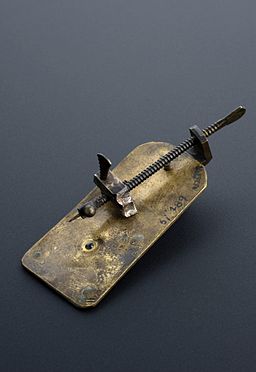History of Science
Edward Hessler
The Leeunwenhoek Microscope
 |
See page for author
[CC BY 4.0 (http://creativecommons.org/licenses/by/4.0)],
via Wikimedia Commons |
One of the surprises of this century is the discovery of three more Leeuwenhoek microscopes. It was in 1674 that Leeuwenhoek introduced us to microscopical biology. He discovered another world: microorganisms.
One of the newly found microscopes was locked away for two decades, one was found in a box of silver trinkets and one was found in the mud of a canal bottom. The total of surviving microscopes attributed to Antony van Leeuwenhoek (1632-1723) is now twelve.
Brian J. Ford author of
Leeuwenhoek Legacy, discusses these newly discovered microscopes
here. He describes the legacy of Leeuwenhoek, summarizes data on each of the twelve existing microscopes in a table (metal, magnification, owner, place, provenance, authenticity--whether they are thought to be genuine) and the use of SEM
macrography in authentication. This was the first time this technology has been used and it has shed light on what may turn out to be a method of authentication. It turns out that details of manufacture leave their unique marks.
Leeuwenhoek constructed some 500 microscopes during his lifetime. Ford
notes that 26 silver microscopes were bequeathed to the Royal Society
but these were later removed by a Victorian surgeon, Sir Everard Home.
It is likely that these were destroyed when his house burned to the ground.
 |
By Jan Verkolje (1650—1693)
(http://ihm.nlm.nih.gov/images/B16786)
[Public domain or Public domain],
via Wikimedia Commons |
Leeunwenhoek's investigation into Microscopes
Following a visit to London where Leeuwenhoek had seen a copy of Robert Hooke's magnificent
Micrographia he developed his own design for a simple microscope as described by Hooke in his Preface to the book. These are small microscopes, about the size of a postage stamp. They are not easy to use but Leeuwenhoek was patient and persistent. This
Wiki entry provides many more details about him and his long life. His profession was draper; his avocation was science.
One of the early alphabet science programs in the 1960s,
ess (elementary science study) developed a teaching unit titled "Small Things," designed to introduce children to the microscopic world. It included a facsimile microscope made mostly of wood based on Leeuwenhoek's design and used a glass bead for the lens. It also included a reflecting mirror and a focusing mechanism.
The kit was published in 1964 by McGraw-Hill Book Company.













